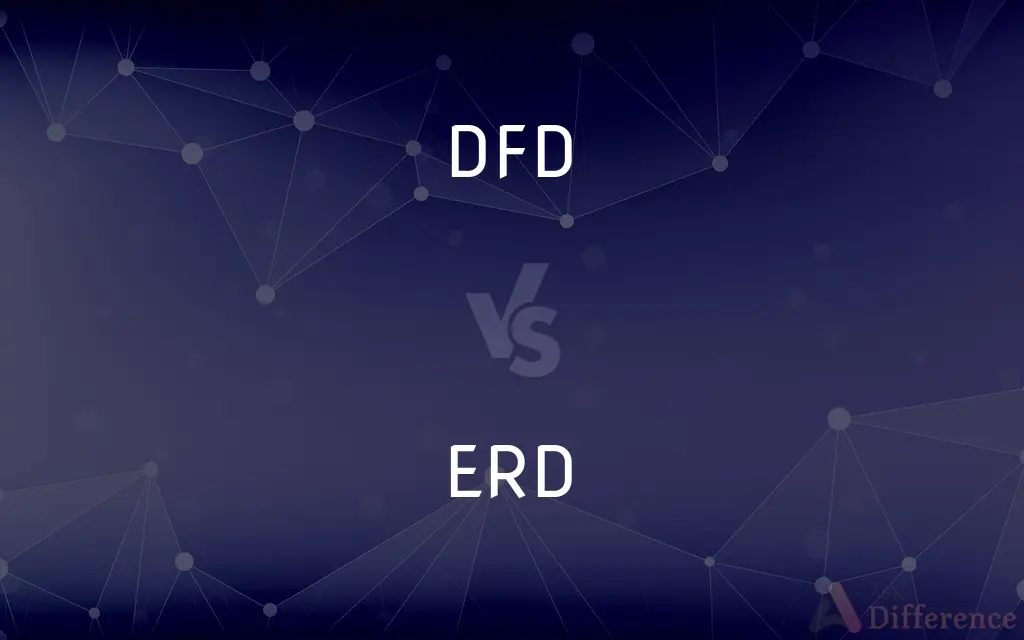DFD vs. ERD — What's the Difference?
By Tayyaba Rehman — Published on January 25, 2024
DFD (Data Flow Diagram) illustrates the flow of data within a system, focusing on the processes and data movement, while ERD (Entity-Relationship Diagram) represents the entities within a system and their relationships.

Difference Between DFD and ERD
Table of Contents
ADVERTISEMENT
Key Differences
Primary Focus: DFDs primarily depict the flow of data between processes and data stores in a system. ERDs focus on the structural organization of data, detailing how different entities relate to each other.
Components and Representation: A DFD consists of processes, data flows, data stores, and external entities, emphasizing how data moves and is processed. An ERD includes entities, attributes, and relationships, showcasing the database structure.
Usage in System Development: DFDs are used to understand, analyze, and communicate the processes and data movement in a system, often in initial stages of system design. ERDs are used for database modeling and design, crucial for database development.
Complexity and Details: DFDs can be more straightforward in representing data flow without delving into detailed data structures. ERDs provide a more detailed view of data organization, crucial for database design.
Use Case Examples: A DFD might be used to map the process of customer order processing in a retail system. An ERD would be used to design the database that stores customer, order, and product information.
ADVERTISEMENT
Comparison Chart
Focus
Flow of data within a system
Structural organization of data
Main Components
Processes, data flows, data stores
Entities, attributes, relationships
Usage
Process analysis and system design
Database modeling and design
Complexity
Less detailed, more focused on flow
Detailed view of data structure
Example Use Case
Mapping a customer order process
Designing a customer order database
Compare with Definitions
DFD
A diagram showing data movement and processing in a system.
The DFD clearly illustrated the patient information flow in the hospital system.
ERD
A diagram that shows the relationships between entities in a database.
The ERD was crucial in designing our new customer database system.
DFD
A visual tool for mapping out data processes and flows in software development.
The software engineer presented a DFD to describe the application's data lifecycle.
ERD
A graphical tool used in database design to illustrate entities and their relationships.
She used an ERD to demonstrate how different tables in the database relate.
DFD
A graphical representation of how data flows through a process or system.
In our meeting, we used a DFD to explain the data processing in our new app.
ERD
A visual representation of the data structure within a system or database.
The ERD provided a clear overview of the entity connections in the software.
DFD
A schematic describing the pathways and processes for data handling.
Our project team created a DFD to detail the customer data flow.
ERD
A design tool that helps in visualizing database structure and entity interactions.
Our ERD helped identify relationships between various data points in the system.
DFD
A tool used in systems analysis to depict data sources, destinations, and storage.
The system analysis report included a DFD showing data storage and retrieval.
ERD
A schematic used to represent data models, showing how entities are connected.
The database developer created an ERD to show the company's data model.
Common Curiosities
What does an ERD represent?
An Entity-Relationship Diagram shows the relationships between entities in a database.
Can DFDs help in improving system efficiency?
Yes, by identifying redundancies and streamlining data processes.
What is a DFD?
A Data Flow Diagram that maps out the flow of data in a system.
When is a DFD used?
It's used during the planning and analysis phase of a system to understand how data moves and is processed.
Is ERD useful for non-technical stakeholders?
Yes, it helps them understand the database structure and relationships in a more intuitive way.
What skills are needed to create a DFD?
Understanding of system processes and basic diagramming skills.
Can DFD be used for both manual and automated systems?
Yes, DFDs are versatile and can be applied to various types of systems.
Are DFDs and ERDs used together?
Often, as they complement each other in system analysis and design.
Are ERDs limited to relational databases?
While commonly used for relational databases, ERDs can also represent other types of data models.
What is the purpose of an ERD in database design?
It's used to visualize and design the structure of a database, showing how tables are interrelated.
Can these diagrams be created with software tools?
Yes, there are various software tools available for creating both DFDs and ERDs, facilitating easier and more accurate diagramming.
What's the difference in focus between DFD and ERD?
DFD focuses on data flow and processes, while ERD focuses on data structure and relationships.
How detailed is a DFD?
It can vary from high-level overviews to detailed representations of data flow.
What skills are needed to create an ERD?
Knowledge of database concepts and relationships.
Do ERDs include attributes of entities?
Yes, ERDs typically show attributes along with entities and relationships.
Share Your Discovery

Previous Comparison
Sweetest Day vs. Valentine’s Day
Next Comparison
Long Layers vs. Short LayersAuthor Spotlight
Written by
Tayyaba RehmanTayyaba Rehman is a distinguished writer, currently serving as a primary contributor to askdifference.com. As a researcher in semantics and etymology, Tayyaba's passion for the complexity of languages and their distinctions has found a perfect home on the platform. Tayyaba delves into the intricacies of language, distinguishing between commonly confused words and phrases, thereby providing clarity for readers worldwide.











































